Erich Hartmann’s last 109
By the Spring of 1944, the Bf-109G-6, which had been the primary production version of Messerschmitt's fighter since the previous fall, was falling behind in the relentless race for performance. Beginning in the late spring, many airframes were re-engined with the DB605D, on which an increased-diameter supercharger had been fitted and compression raised to from 7.3/7.5 to 8.3/8.5, using standard B4 (87 octane) fuel with methanol-water (MW50) injection, to provide 1,800 h.p. for take-off and 1,600 h.p. at 6,000 meters. That summer, production “standardized” on the Bf-109G-14, which could use this engine or the DB605CD, which utilized C3 (96 octane) fuel and MW50 to provide 2,000 h.p. for take-off and 1,800 h.p. at 6,000 meters.
That fall, the redesigned Bf-109K-4 came into production and reached the Jagdwaffe beginning in mid-November 1944.
The Bf-109G-10 began life as a way of modernizing the Bf-109G-6 airframe to make it as much like a Bf-109K as possible. This version, all of which were re-manufactured G-6 airframes, did not enter service until January 1945, after the introduction of the Bf-109K-4, which has spread no small amount of confusion among Bf-109 “experten”. Coupled with the fact that the G-10 could appear with either engine, with or without an extended-leg tail wheel like the K-4, with or without the taller wooden rudder of the K-4, G-14, and late production G-6, and with or without the larger wheels and associated upper wing fairing of the K-4 variant, it is close to impossible unless one can discern a Werkenummer in a photograph, and has access to a list of sub-types by serial number (and even then it is not a 100% lock since the records are not totally complete), to determine if one is looking at a Bf-109G-6AS, a Bf-109G-14AS, or a Bf-109G-10. There are few photos available of any of these late war types to top it off. The only version of the Bf-109G-10 that can absolutely be identified as such is the Erla-built version, due to the fact that it lacked the curved cowling fairing on the left side of the forward fuselage immediately below the windscreen, this being replaced by a square-shaped panel. Additionally, this sub-type does not have under cowl bulges on the lower nose, and does have a shallower, wider oil cooler radiator.
What is known definitely about the Bf-109G-10 is that it was the final type to equip Squadrigli of the Aviazione della R.S.I., aka Aeronautica Nazionale Repubblicana, or ANR, as well as the last type to equip the Croatian Jagdstaffel that flew with the Italians in the last months of the war, and that it was issued interchangeably with the Bf-109K-4 to Luftwaffe Geschwadern in the last months of the war. It was acknowledged as the fastest of the series, with a top speed at altitude of 452 m.p.h., slightly faster than the Bf-109K-4. As far as having any effect on the war, the airplane may as well not have existed; by the time it arrived, the Luftwaffe had shot its final bolt in Operation Bodenplatte, and was a spent force with few leaders left alive, fewer pilots of any ability left on operations, and an uncertain supply of aviation gasoline which meant most of these airplanes were supplied to a unit that never flew them before they were lost to Allied strafing in the few months after the Battle of the Bulge that spelled the end of the Nazis and their “Thousand-Year Reich.”
Erich Hartmann:
Erich Hartmann's name is well-known to aviation enthusiasts as the highest-scoring ace of all history with 352 aerial kills. This score is even more amazing when one considers that he did not arrive at the front until the summer of 1942 - well past the "glory days" of the Luftwaffe. Once he got over his "buck fever" - he turned tail and ran when he entered his first combat - Hartmann was a gifted pilot in a target-rich environment. He was always outnumbered by his Soviet foes. Flying three and four missions a day every day, he had over 100 victories by the conclusion of the Battle of Kursk in July 1943 - a year after he entered combat - and another 100 by the end of 1943. Beginning with the mission of July 7, 1943, Hartmann began scoring multiple victories because he had learned the essential trick of a successful fighter pilot, to close to point-blank range before opening fire. This way, it only took three or four hits with his 20mm cannon to explode an enemy fighter. As he put it, "Get close. When he fills the entire windscreen, then you can't possibly miss." . Hartmann claimed that of all his accomplishments, he was proudest of the fact that he never lost a wingman.
Born in 1922, in Weissach, Wurttemberg, Hartmann joined the Luftwaffe in 1941 at age 19, and was posted to Jagdgeschwader 52 on the Eastern Front in October, 1942. He scored his first kill that November, and only achieved his second three months later.
As he worked out the tactics which would prove so successful later on during the Spring of 1943, he would normally be content with one victory, being willing to wait for another day. His natural talents began to tell: excellent eyesight, lightning reflexes, an aggressive spirit, and an ability to stay cool while in combat. As he developed the coolness to close with the enemy, he started scoring multiple victories, such as his missions on February 26, 1944, when he scored his 200th victory. That day, he shot down ten P-39 Airacobras over three sorties.
In June and July 1944, operating in Romania, Hartmann engaged in combat with American fighters for the first time, and shot down six.
Over the month of August 1944, Hartmann claimed 35 victories, including eight on August 23, which was followed the next day by shooting down 11 enemy aircraft to become the first pilot to score more than 300 victories.
Following this, Hartmann was prohibited from flying combat and assigned to Erprobungskommando 262. In October, the prohibition on combat flying was lifted and he was appointed Staffelkapitän of 4./JG 52, then in Hungary. By the end of the year, his tally was 331. Hartmann briefly led I/JG 53 as acting Gruppenkommandeur from February 1-14, 1945, before turning over command to Hauptmann Helmut Lipfert and becoming Gruppenkommandeur of I/JG 52. In March he was transferred to Lechfeld for training on the Me 262 to join JV 44, but he requested a return to JG 52, due to his feeling that the young pilots needed his skills more than the experten of JV 44 did. On April 17, he scored his 350th victory, and was promoted to Major at the end of the month. On May 8 - the last day of the war - he claimed his 352nd, and last, victory against a Yak-9 over the Brün area in Czechoslovakia.
Later that day, the Luftwaffe command ordered Hartmann and his Kommodore, Hermann Graf, to fly to the British sector. Both disregarded the order because they were responsible for Jagdgeschwader 52's pilots, ground crew, family members, and other civilians who had joined the squadron seeking protection against Czech partisans. They ordered the destruction of the unit's aircraft, then moved west. At the end of the day, they surrendered to the U.S. Army on the Bavarian-Czech border. However, on May 17th, the Americans delivered the higher-ranking members of JG 52 to the Soviets.
With the rest, Hartmann was sent to Siberia, where he was sentenced to 50 years at hard labor. During his imprisonment, the Soviets pressured him to support the establishment of an East German air force and tried to turn him into an undercover agent against the West. He refused, even though the Soviets threatened to kidnap and kill his wife and daughter, who were living in West Germany. Hermann Graf accepted the offer and was released from the gulag in 1953. Hartmann returned to Germany on October 15, 1955, when the last German POWs were released following the establishment of diplomatic relations between West Germany and the Soviet Union.
In 1956, he joined the newly-established Bundesluftwaffe and in 1959 became the first Kommodore of Jagdgeschwader 71 "Richthofen." His career suffered when he opposed the introduction of the F-104 Starfighter into the Luftwaffe on grounds that the service did not have the experience to successfully operate such a high performance jet at that time, an opinion later proven right with the horrendous loss rate and fatalities following the F-104's entry into operations up until the mid-1970s.
Retiring as a Colonel in 1970 over these severe differences with his old comrade Gunter Rall, who was the leader of the F-104 faction in the Bundesluftwaffe, Erich Hartmann died in 1993. He had flown 825 missions in recording 352 victories, a record for endurance in combat. His victories included 15 Il-2 Sturmoviks. He was shot down and force-landed 14 times during his combat career.
The kit
Hasegawa's series of 1/32 Bf-109s includes all major variants of the F, G and K series, and is one of the best 1/32 kits available. The kits have been reviewed many times elsewhere.
The Cutting Edge resin conversion, CEC32139, allows a modeler to build the Erla "Type 110" Bf-109G-10, and includes a completely new cowling and all fairings. Long out of production, these sets can be found for expensive prices on eBay. Interestingly, the Revell 1/32 Bf-109G-10 issued last year, has the Type 110 "Erla cowling," for $29.99.
Construction
I had done this conversion before, and had put that model out at Planes of Fame for display. I hadn't really been that happy with the final result of that project, so when the opportunity presented itself for a “mulligan,” I picked up the kit and the conversion set from a friend who had decided the project was more than he felt comfortable with back in 2008.
Since I doubt there is a modeler who builds 1/48 World War II aircraft who hasn't done at least one each of the Hasegawa 109s, I will merely state here that construction of the 1/32 kit is straightforward and easy if one follows the instructions - perhaps even easier than the 1/48 kits. The basic 109F/G/K wing has holes to be drilled out for the upper wing wheel bulges and the FuG16zy Morane antenna. The cockpit is sparse in its detail though acceptable (and much more than you get in 1/48 scale), and the model will benefit from an aftermarket resin cockpit, as I used here, this one being one of the excellent cockpits offered by Cutting Edge, in this case being a cockpit for a Bf-109G-6, since the Bf-109G-10 had been rebuilt from the G-6 (how's that for a fancy way of saying “I used the cockpit I had”?). I also decided, after looking at some pictures of identifiable Erla-built G-10s, that the majority seemed to have the short tail wheel (another fancy way of saying “I didn't want to get into scratchbuilding a long tailwheel leg”). These really were easy choices, since there are no detail photos of the particular airplane I was re-creating.
There is a lot of cutting and fitting to be done in attaching the resin cowling to the fuselage, but this is no problem for anyone who has a couple of conversions under their belt. The parts are designed to fit the Bf-109G-14 kit, and are overall excellent. Once the resin cockpit was freed from its molding blocks, it was painted and detailed, then installed in the fuselage. Construction was straightforward past that.
Colors & markings
There are not many photographs of late war Bf-109G-10s, and there is only one photograph still in existence of the Bf-109G-10 that Hartmann flew at the end of the war. This shows that the airplane was an Erla-built “Type 110" (since you can see the flat panel on the left forward fuselage) and that the fuselage was moderately mottled. Thus, I painted the model in a late-war standard Erla scheme for the upper wings and tail surfaces, using Xtracrylix RLM 75 Grauviolett, RLM 82 Dunkelgrun and RLM 76 Blaugrau paints, freehanding the camouflage with my Paasche-H and going for the “splat” look of the blotches, as seen in the photos Brett Green took of the only Bf-109G still in original paint, at the Australian War Memorial. I painted the “hard edge” mottles on the vertical fin with a brush, as well as the RLM 76 squiggles on the rudder. When this was done, I gave the model an overall coat of Xtracrylix Gloss varnish.
Decals:
I pieced together markings for this from Aeromaster and Eagle Editions sheets that had markings for Hartmann's other airplanes. While he dropped the use of the black tulip petals after putting them on his Bf-109G-6 “Weiss Ein” in the fall of 1943, due to the danger of becoming too well-known to the Soviets were he shot down, he put the marking back his Bf-109G-14 when he became Staffelkapitän of 4./JG 52, then Gruppenkommandeur of I/JG 53, as a way of raising the morale of the young, undertrained Nachwuchs he commanded, and he retained those markings on his Bf-109G-10 when he took over I/JG 52 for the same reason. I used the “Usch” heart he had on the Bf-109G-14 in I/JG 53, reasoning he would have used a similar simplified marking on this last airplane. The Gruppenkommandeur's double chevrons came from a left-over Hasegawa kit decal sheet for the Fw-190D-9
Final construction
Reasoning that Hartmann had this airplane, which he later said was his favorite of all the 109s he flew, for only about seven weeks at the maximum, during which time the unit did not fly every day due to fuel shortages, I decided it likely it had not had much time to get “dinged” or faded, and thus limited the wear and tear to exhaust stains on the fuselage sides and the bottom of the airplane.
Cnclusions
For someone who doesn't consider himself a member of the 109Nutz Fraternity, I certainly seem to have collected and built a fair number of these 1/32 Hasegawa 109s, and now the Eduard kits. The kit goes together so well that an average modeler can come up with an excellent model out of the box. Then there is the myriad of camouflage patterns, colors, and markings that are possible (my favorite part of modeling is painting and decals). I like these better than the 1/48 kits, but as SWMBO says, that's likely due to the fact that “artists like big canvases.”
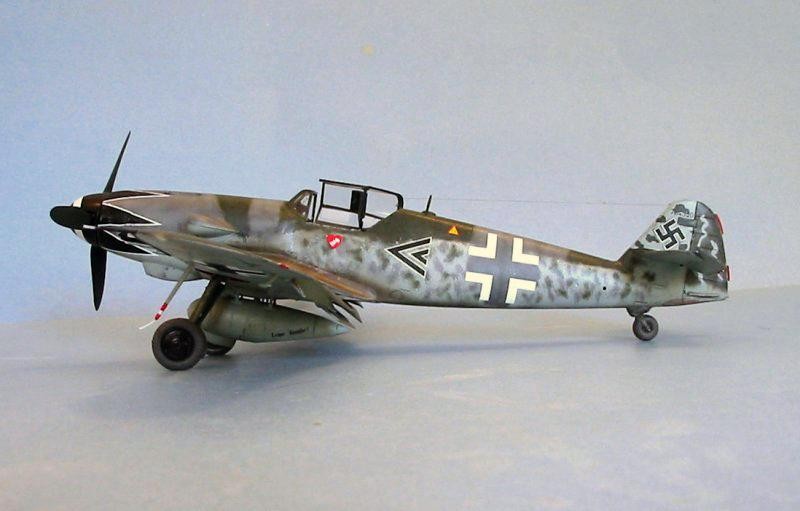
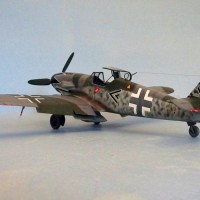
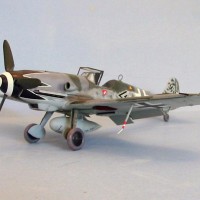
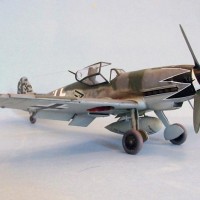
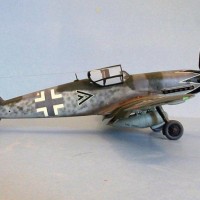
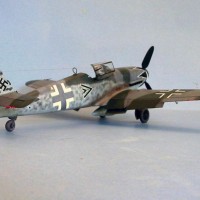
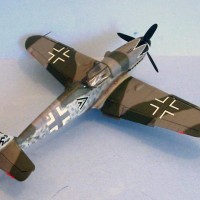
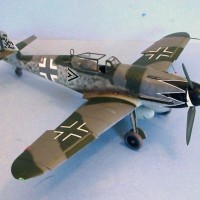
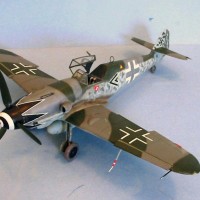
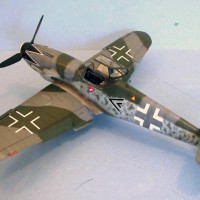
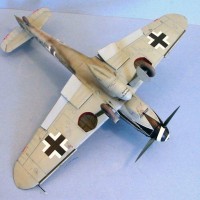
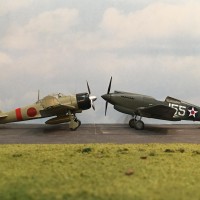
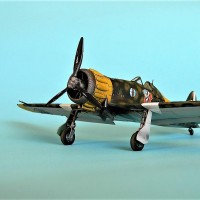
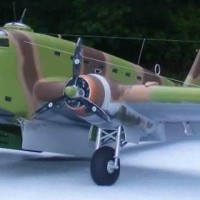
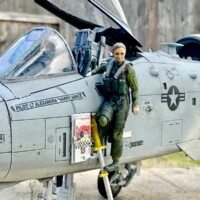
Yet another nice build and photo spread, TC...gotta love them 109's - 🙂
Very nice Tom. Such is the confusion of the late war Luftwaffe
Terrific write up that very much brightened up my commute this morning. I really like this color scheme and to my eye you've executed it brilliantly. I'm not a jet age aficionado but I have the Kinetic 1/32 Mk 6 Sabre (my favourite Cold War jet by a mile) and it's close to getting on the bench to be done in Bubi's black tulip colors.
Thanks for the read, TC.
Get at least the AMS Resins ejection seat, if not the full cockpit, to get the most of that kit. The stuff is available at Sprue Brothers.
When I first saw the kit, I thought the surface detail was heavy, then I went and looked at the three Sabres at Planes of Fame and realized it was just right. Amazingly, that wing center section is filled with Phillips Head screws!
I'll get onto that popular internet market place this evening, TC. Thanks for the heads up.
Very nice work with the Messer and it was a pleasure to read the brief history of Hartmann's career.
Another great model, Tom. Even better, however, is the great narrative, something that always make your posts so special...I always learn a lot when reading them. Thanks for a great. post.
Really nice 109! Great build.
A lovely build Tom! I too don't consider myself a "109 fan," but like you I also can't dismiss all of those variations and paint schemes - especially the Hartmann Tulip!
There is, I think, 2 pictures of Hartmann`s mount, and they show the fuselage camo, and part of the wing. I recon you strayed from the pic with the paint job...
Just my 2c: the cowling camo on the model is wrong, the demarcation should be way higher. The canopy frame should be a darker color(almost certainly Rlm66),considering the camo pattern, small wheel bulges and canopy mast, the rear wheel should be tall, and the rudder/tail solid color with splotches(not a prefab/prepainted job). Erla had a distinction to use RLM 76/75/74 colors till almost the very end when it started producing solid color Rlm81 planes. The wing pattern is also, very probable, Erla specific saw-toothed.
While a nice model, it seems to me you styled it to a K-4 likeness( camo pattern is quite K-like with the demarcation line on the fuselage and prefabricated tail unit) which is not correct. The fuselages of G-10s were not rebuilt, they were brand new. While my claims are impossible to back with absolute certainty, it is based in comparison of lots of pictures of Erla birds. Sorry if I sound harsh, but I think it should be said with all the work you put in.
1 attached image. Click to enlarge.
Great looking 109!
Tom, a cracking model and a great narrative, not least upon the vagaries that abound for the modeller when approaching the later 109s (and actually many aircraft - even the most famed). Most times we approach builds with nothing remotely approaching the certainty of perfect evidence. Often in a set of kit instructions we get to see the '?' symbol that gives us options based on 'we don't really know'. Your piece walks us through the minefield of building without full records - photographic or written. Many Museum pieces are now in non-standard camo or built with replacement or inaccurate parts (the Dora's wings etc.).
For me, the fact that you have written to all options - those you chose, and those you didn't - justifies your interpretation - which without complete evidence is what we are all challenged to do on a daily basis in this hobby. The fact that different production batches of the G-10 were known to be released by different factories at different times, probably using up parts from previous variants at different rates, and probably even involving pre-tooled parts for the 'H', just adds to the mix! What we don't 'know' is always at least as interesting as what we do!
While I agree there are unnkowns, there are many knowns...and its quite easy to get the info without books. I also am on the bandwagon of asuming stuff sometimes, but its quite safe to say sometimes if it looks like a duck, quacks like a duck...
Plus, not to insult anyone, but there is a famous picture of Hartmanns plane in question, and the paintjob on the model wildly differs from it. So it's not a question of interpretation or not.
Plus, Occams razor rule
I think you've made your point. The model was made in 2006. With the then-available information. I note that the "Falke Eins" site has only been up since 2009.
Thanks for the reply Matija, I can see we may not agree on some of this, but I am happy to generate a little debate, in the right spirit.
Can I ask if the photo you attached is the 'famous' one you speak of, or if it is the other one of Hartmann standing in front of the plane? Or another one entirely (you mentioned 2, but I should check - mostly because I'd love to see another picture to set me straight)? Either way I'd suggest that a choice of colours and tones based on an older black and white exposure will always be a question of interpretation, even if we know the most likely RLM combinations.
Looking at the two photos, the way they have been processed, or have aged, or the light (or even atmospheric conditions) they were taken in, or the film type used, or the distance from the subject, will change what we see (there are other variables of course, certainly too many to list here). Now that we are looking at two views of the same thing which look slightly different we are really into the business of interpretation when we make our version in plastic.
I think it is the 'pattern' used that is causing you most to take issue? Please correct me if I am wrong. I agree if you are reading from the photo for the parts of the plane you can see - some of it is different. 'Wildly different' is, for me, too strong. If there is no actual evidence for the parts of the plane outside of the photographic frame it will undeniably mean extrapolating from the 'data' we have, about what is most probable for those non-visible parts - clearly legitimate enough (even if it doesn't necessarily get us to the true value of anything). It generates a best guess - as with Occam's razor. Looking at the more 'contrasty' of the two photos, specifically at the wing, it appears very different to the shot you attached although it is clearly the same plane. I see no evidence for the sawtoothed camo scheme in either photo. I'd go so far as to say the one with the pilot in front would more strongly support no sawtoothed version in this case - but that's my interpretation of the photo. Your take here comes from your expectations of the way some Erla versions looked, and is absolutely valid.
So I imagine we will respectfully agree to disagree on some of this, Matija, and that is healthy. You know more about 109 G-10s than I, and we can see some differences between the parts of the plane in the picture and Tom's model. I can't see the sawtoothed camo or any of the rudder. I could make my most likely guess about what was outside the photo's frame (especially if it were a duck!). But I wouldn't be able to tell you much more than its form with confidence. Its DNA (a metaphor for its detail) would be too difficult to discern or debate. Occam is clear that you use the razor sparingly when more inquiry is required. For this specific aircraft - regarding the rudder and wing camo and perhaps even the tail wheel - we'd agree (hopefully) that is the case, even if the pictorial evidence may not exist. Finally on Occam - the complexity of choices is probably relevant - you see a clearer path to the conclusion than I do. I am, rightly or wrongly, more open to the possible variables. Although we might choose the simplest route, that complexity is accepted as having an effect on the razor's sharpness! It is after all an heuristic rule of thumb and not an absolute.
I am happy to play devil's advocate here a little, Matija - but in a very respectful way. In all of this it is delicious irony that Tom is known for his helpfulness in correcting fellow modellers in order to help them to improve. Hopefully he approves of this debate! Whatever the last word on this, I am happy for you to have it, as I would hate to remotely stray from the general iModeler ethos of camaraderie and learning.
Of course I approve. 🙂
Well, it
s quite possible Im wrong, dont get me wrong. However, with the amount of info available, its possible to make a reasonable assumption...I will refer again to the cowling on the pictures(yes, those are the two I was talking about). On the pictures you can clearly see the high demarcation line between the top two camo colors and the lighter fuselage color. Tom did it waaaay lower, as K-4 line of Bf109s had(one of two very typical schemes). I have no way to know when the model was made, but there it is, that part is painted wrong.
As far as the rudder/tail paint, lets just again say that Erla had a very organized paint distribution and parts supply. There was no need to get the subcontractors prepainted parts. Hartmanns mount is the early example, and those planes were very typical, in parts and paint. So, if a plane that was made before his had sawtoothed camo, and the plane after it, it
s quite probable his had it too. Short back wheel, well, again, not a typical thing to see on an early Erla. Apart from the cowling camo pattern being what it is on the model, yes, all those thing are possible. Just not very likely. The reason Im even getting into a discussion is my(maybe erroneous) thinking we should try to correct a mistake. Someone, somewhere,sometime will see a model and just thing, jeez that`s a swell model. I will make a model just like that one!And I know I am painting myself as a baddie here, but I never was one to just comment for comments sake. Constructive critique here would be, ok, not perfect, whoever decides to make Hartmanns plane, consider different sources
There's a very good possibility they didn't send 109s for remanufacture back to the factory they originally came from, so the sawtooth camo one saw on an Erla G-6 might not be on a remanufactured Erla G-10, not to mention if it was repainted , the "sawtooth" was gone by late 1944/early 1945. Erla G-14s have a more "freehanded" sawtooth scheme.
As regards critical comments, as an artist I have never learned a damn thing from success (other than I like it). Since this model is out at Planes of Fame now, should I decide to pick up that Revell Erla G-10 at the LHS (which has these markings), I would now be making use of the information that wasn't there to be had back in 2006 (Falcke Eins not existing till 2009).
Tom, Nice 109, the Hasegawa kits especially in this scale, still seem to be an excellent kit. It appears to me that the 1/32 scale'r has a little better shaped spinner than the 1/48 scale kit (but it too is an excellent kit)!
My question to you is in regards to Hofer. I had read in numerous books and accounts, that his death was most likely caused by either being shot down or at least shot -up and damaged by an Hungarian pilot: Ensign Leo Krizsevsky (who was killed shortly after), Hofer was then finished off by AA near a German airfield. I was wondering where you got your info, as even with all these accounts, exactly what happened to him remains a bit of a mystery !
The account I posted is information as of 12 years ago.
Tom, @tcinla
Amazing information you provide in there! Thank you for sharing!
Cheers!
Dolf